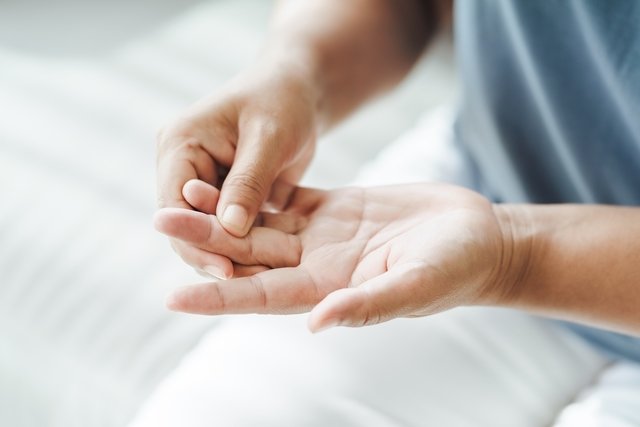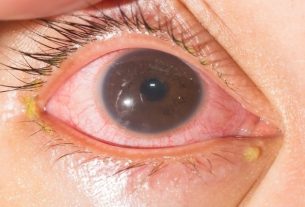Gout, or gouty arthritis, is an inflammatory disease caused by excess uric acid in the blood (in which the urate concentration exceeds 6.8 mg/dL), which ends up affecting the joints. However, not all people who have an increased level of high uric acid will develop gout, as the disease is dependent on other factors.
Symptoms of gout include swelling, redness and pain when moving a joint, with the most affected joint generally being the big toe, which becomes painful, especially when walking.
Gout attacks can improve through an appropriate diet to reduce uric acid levels in the blood. In addition, the rheumatologist or general practitioner may also recommend the use of medicines to block the production of uric acid, such as allopurinol, or medicines to help the kidneys eliminate uric acid in the urine, such as probenecid.

Main symptoms
Gout symptoms arise as a consequence of the deposition of uric acid crystals in the joints, resulting in intense pain in the joint that lasts a few days and worsens with movement, in addition to an increase in local temperature, edema and redness.
The pain, which most often begins in the early hours of the morning, is intense enough to wake the patient up and lasts for approximately 12 to 24 hours. However, after the pain the person may feel discomfort in the affected joint, especially when moving, which can last a few days to weeks, especially if gout is not properly treated. Know how to recognize the symptoms of gout.
Any joint can be affected, however gout is more common in the lower limbs, especially the big toe. There may also be the formation of kidney stones and the deposition of uric acid crystals under the skin, forming protuberances on the fingers, elbows, knees, feet and ears, for example.
Online symptom test
Gout is a type of inflammatory arthritis, such as rheumatoid arthritis or ankylosing spondylitis. To find out the chance of having inflammatory arthritis, please select the symptoms you present:
This test is only a guidance tool and does not serve as a diagnosis or replace consultation with a rheumatologist, orthopedist or general practitioner.
How is the diagnosis
The diagnosis of gout is made according to the patient’s clinical history, physical examination and complementary tests, such as measurement of uric acid in blood and urine, in addition to x-rays.
The gold standard for diagnosing gout is the observation of urate crystals through microscopy.
Causes of gout
Gout occurs as a consequence of hyperuricemia, which corresponds to an increase in the amount of uric acid in the blood, which can occur both due to increased production of uric acid and also due to a deficiency in the elimination of this substance. Other causes of gout are:
- Inadequate medication intake;
- Excessive use of diuretics;
- Alcohol abuse;
- Exaggerated consumption of foods rich in purines, such as red meat, fish, seafood;
- Diabetes;
- Obesity;
- Uncontrolled high blood pressure;
- Arteriosclerosis.
Due to the large amounts of circulating uric acid, there is deposition of monosodium urate crystals, which is the solid form of uric acid, in the joints, especially the big toe, ankle and knees.
The occurrence of gout is more common in people who are overweight or obese, who have a sedentary lifestyle and who have chronic diseases that are not very well controlled. Furthermore, gout is more common in men between 40 and 50 years old and women after menopause, generally over 60 years old.
How the treatment is carried out
Gout treatment is basically divided into two stages: management of the acute crisis and long-term therapy. Treatment for gout attacks involves anti-inflammatory medications that must be recommended by your doctor, such as Ibuprofen or naproxen, for example, to relieve pain and joint inflammation. Another anti-inflammatory medicine widely used to control pain and inflammation is colchicine, which also acts on uric acid.
Corticosteroid medications, such as prednisone, can also be used to treat joint pain and inflammation, however these medications are only used when the person cannot take other anti-inflammatories or when they do not have the desired effect.
In addition to these medications, the rheumatologist or general practitioner can also prescribe medications to control uric acid levels in the blood to prevent new attacks and prevent complications, such as allopurinol or probenecid. See more about gout treatment.
It is also important to change eating habits, as this can directly influence the amount of circulating uric acid and, consequently, the deposition of crystals in the joint, and treat underlying diseases that can also favor the occurrence of gout when left untreated, such as hypertension. and diabetes, for example.
How should the diet be
To alleviate gout symptoms and prevent new attacks, it is important to prioritize the consumption of natural foods rich in fiber, vitamins and minerals, such as fruits, vegetables, whole grains and legumes.
It is also recommended to reduce or avoid the intake of foods rich in purines, such as red meat, fish, chicken or seafood, as they increase uric acid levels in the blood. In addition, you should drink around 2 liters of water per day, as this drink helps to reduce uric acid levels in the blood.

Sign up for our newsletter and stay up to date with exclusive news
that can transform your routine!
Warning: Undefined array key "title" in /home/storelat/public_html/wp-content/plugins/link-whisper-premium/templates/frontend/related-posts.php on line 12
Warning: Undefined array key "title_tag" in /home/storelat/public_html/wp-content/plugins/link-whisper-premium/templates/frontend/related-posts.php on line 13



